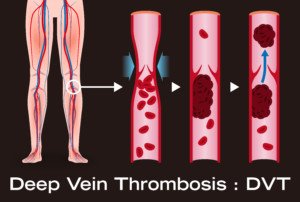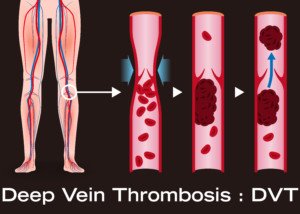Bike riding is a fun way to exercise or just get out there and be active, but what if you have a DVT in your leg?
Is it safe to ride your bicycle or even a stationary bike?
You may have previously discovered there’s no formal information available online on this specific topic, and what information you have found on cycling websites isn’t consistent.
Furthermore, what if your DVT has been complicated by a pulmonary embolism?
“The advice I would give isn’t written in tablets of stone and are just, what I would regard as, commonsense guidelines,” says Dr. David Beatty, MD, a retired general practitioner with 30+ years of experience and an instructor of general medicine for 20 years.
“The management of a DVT would generally involve 24 hours bedrest and the use of compression stockings,” continues Dr. Beatty.
“Painkillers might be needed, and an anticoagulant is started.
“The anticoagulant might be Heparin-type injections which are converted to warfarin tablets (or similar drug).
“In recent years the newer anticoagulants, such as apixaban [Eliquis] or rivaroxaban [Xarelto] tablets have come into favor, because injections aren’t needed, and regular blood test monitoring isn’t needed,” when one uses these medications.
Getting Back on Your Bike After a DVT Diagnosis
“Gentle mobilization starts with walking,” says Dr. Beatty.
“Cycling on an exercise bike can be slowly started when pain-free. Listen to what your body is telling you, and if pain develops take a step back.
“Don’t do any strenuous exercise in the first two weeks. The aim is to very gradually increase your exercise.
“If things are going well you might be at your pre-DVT exercise levels by week 4.
“Many regular cyclists are mustard keen to get back outside on their bikes,” and this includes more rigorous activity such as mountain biking.
“Road cycling involves the risk of crashing, and if you’re on an anticoagulant there’s a chance of severe bleeding after a fall.
“For this reason it’s common sense not to cycle outside until your course of anticoagulants has finished.
“The typical course is three months, but can range from six weeks to long-term, depending on various factors.
“In the event of hemorrhage, warfarin can be reversed with vitamin K, but there is no antidote to the newer anticoagulants.”
DVT Prevention While on a Bike

Shutterstock/metamorworks
“Dehydration is a risk factor for DVT, so keep well-hydrated,” says Dr. Beatty.
“Being stuck in one position is another risk, so try to vary your cycling position.
“I can see how being in the flexed position, with your head down over the handlebars, could cause a partial blockage to the flow of blood through the femoral vein in the groin.
“Spend time sitting up to straighten the legs, and get off the bike to do some stretches.
“Strong cyclists will often have large calf muscles and these could, in theory, partly block the vein.”


 Dr. Beatty has worked in primary medicine, surgery, accident and emergency, OBGYN, pediatrics and chronic disease management. He is the Doctor of Medicine for
Dr. Beatty has worked in primary medicine, surgery, accident and emergency, OBGYN, pediatrics and chronic disease management. He is the Doctor of Medicine for 












